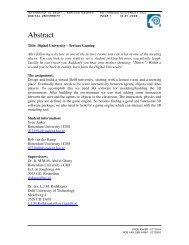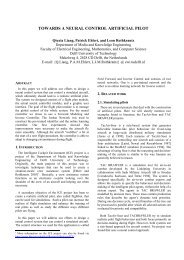Recognition of facial expressions - Knowledge Based Systems ...
Recognition of facial expressions - Knowledge Based Systems ...
Recognition of facial expressions - Knowledge Based Systems ...
Create successful ePaper yourself
Turn your PDF publications into a flip-book with our unique Google optimized e-Paper software.
Bayesian networks were designed to encode explicitly encode “deep knowledge” rather<br />
than heuristics, to simplify knowledge acquisition, provide a firmer theoretical ground,<br />
and foster reusability.<br />
The idea <strong>of</strong> Bayesian networks is to build a network <strong>of</strong> causes and effects. Each event,<br />
generally speaking, can be certain or uncertain. When there is a new piece <strong>of</strong> evidence,<br />
this is transmitted to the whole network and all the beliefs are updated. The research<br />
activity in this field consists <strong>of</strong> the most efficient way <strong>of</strong> doing the calculation, using<br />
Bayesian inference, graph theory, and numerical approximations.<br />
The BBN mechanisms are close to the natural way <strong>of</strong> human reasoning, the initial beliefs<br />
can be those <strong>of</strong> experts (avoiding the long training needed to set up, for example, neural<br />
networks, unfeasible in practical applications), and they learn by experience as soon as<br />
they start to receive evidence.<br />
Bayes Theorem<br />
P ( h | D)<br />
=<br />
P(<br />
D | h)<br />
P(<br />
h)<br />
P(<br />
D)<br />
In the formula,<br />
P(h) is prior probability <strong>of</strong> hypothesis h<br />
P(D) is prior probability <strong>of</strong> training data D<br />
P(h | D)is probability <strong>of</strong> h given D<br />
P(D | h) is probability <strong>of</strong> D given h<br />
Choosing Hypotheses<br />
Generally want the most probable hypothesis given the training data<br />
Maximum a posteriori hypothesis h<br />
MAP<br />
:<br />
h<br />
MAP<br />
= arg max P(<br />
h / D)<br />
h∈H<br />
P(<br />
D | h)<br />
P(<br />
h)<br />
= arg max<br />
h∈H<br />
P(<br />
D)<br />
= arg<br />
max P(<br />
D | h)<br />
P(<br />
h)<br />
h∈H<br />
- 32 -
















